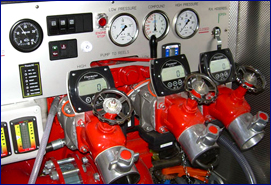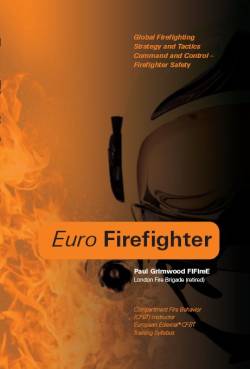At its simplest the flow rate is the amount of extinguishing media, in this case water, that is being applied to a fire at any one time, referred to in liters per minute (l/m)

Photo: TSI Flowmeters
Required flow rate may be simply viewed as the amount of water required to control and ultimately extinguish a fire. This introduces many variables. To be more precise there are two flow rates we need to consider :
Critical Flow-rate (CFR) : Typically this would be the absolute minimum amount of water-flow needed to fully suppress a fire at any given level of involvement.
Tactical Flow-rate (TFR) :Is the target flow for a primary attack hose-line(s).(Grimwood)
The actual CFR is dynamic and is directly related to the phase of the fire and this may be unknown. It also has no built in safety factor.. Of more relevancy is the TFR which more accurately represents the flow rates required by fire-fighters to deal with a given fire in a known compartment.
For fires in High-rise buildings we need to build in the factors and issues created by potentially wind driven incidents, typically resulting in higher energy release rate fires.
There is an existing body of statistical data that looks at the required flow rates for any given fire. From this are various "fire ground" approximation tools that will help fire-fighters calculate the flow rate needed for any given fire. These are normally based on either ventilated or fuel phase fires.
Unfortunately there is very little research into the required flow rate for a wind driven fire, where the fuel is being over oxygenated and the energy release rates are substantially higher.
Many research documents identify the issues relating to high rise fire flow rates and are specific in pointing out the requirement of an unusually high flow. What they do not do is suggest appropriate flow rates. Unfortunately, it may not be wholly appropriate to apply some of these previously proven "fire ground" approximation methodologies to the wind driven fire.
Initially we need to discount High Pressure Hose Reels. The use of these is extremely limited and may only be considered at very low floor level, to a fire that can be fully observed and can be deployed from an external entry point (a ladder).
An internal attack on a fire in a high rise building will, in nearly every circumstance, be facilitated by the fixed fire fighting installations within that building. This usually consists of WET or DRY risers (standpipes). These provision water delivery to the incident floor. They have a finite capacity based on there diameter, inlet pressure/outlet pressure and, for dry risers, height of incident.
Calculation must be for each individual hose line and the cumulative requirement for the entire fire fighting attack. Standard practice (and design requirements) usually mean that UK Dry risers are pumped at 10Bar (@150psi) pump outlet pressure, through twinned 70mm hose lines.
A starting point may be that we need to provision firefighters with highest flow rate (that crews are capable of advancing) capable of keeping them safe if they make entry to a compartment and the fire is (or becomes) wind driven. These fires are known to release energy rates at the extreme end of the capabilities of fire-fighting hose lines (17MW+) In all cases it should be best practice to have a fully functional, crewed, backup line, in place, Ideally with the same (or better) performance abilities as the primary attack line, ready for any emergency retreat. These Primary attack and backup lines should be able to flow 500L/m minimum (8.3 L/s). This correlates to flow rates requires in large volume structures and is referenced in the Buildings Disaster Assessment Group (BDAG) paper "Effect of reduced pressures on performance of fire fighting branches in tall buildings"
It is critically important that FRS's test and measure the performance of Wet and Dry risers in buildings that they respond to in advance of any incident. This needs to be carried out in 'worst case' situations; namely at the highest floor levels where there are usable outlets. This intelligence must be available to first attending crews so that they are able to better formulate tactics based on the actual water supplies (flow rates) they can expect.
We must also be aware that some of the 3D fog fire fighting techniques may be inappropriate as the inlet pressures required for suitable branches may not be achievable.
Achievable flow rates (using Dry risers)
There are many variables that will affect the final flow rate. These include, Incident height, Riser diameter, Riser pipework layout, Inlet and outlet losses, Hose line frictional loss and Branch/nozzle selection.
Many of these will be unknown and not easy to quantify. Some are researched and it should be expected that the incident commander build these into any water plan supporting active fire fighting.
Incident height: Pressure loss through static head (P loss) = 0.1 bar per metre.
If we assume a notional height of 3m for each floor then for every floor we loose a third of a bar. So in this example, on the 15th floor we would loose 5 bars just through static head loss.
Riser Diameter: Two common diameter sizes will be found in the UK: 4 inch (100mm) and 6 inch 150mm). They relate to the requirements of building regulations. The internal diameter and condition (roughness) of the inner surface of the pipe will create a frictional loss as water travels along it. It will be difficult to quantify at an incident but for pipes in near perfect condition the losses in 100mm dry risers may be ten times that of 150mm pipe
Riser pipe layout: Every bend and join in the pipework will ass a small amount of frictional loss.
Inlet and Outlet losses: As water travels into the riser system (through collecting heads) it has to navigate past non-return mushroom valves. Also at each outlet there will be losses through the control valve and any breechings used.
Hose line frictional loss: These can be significant and can have a devastating effect on flow rates. relying on old fashion fire ground estimations of frictional loss is inappropriate and dangerous.
resent research by an acknowledged expert in pumping and water delivery flow rates has identified that the frictional loss in hose are much higher than was previously expected. With 45mm Duraline hose at TFR of 500l/m their may be losses of 1.5 Bar .
Firefighters must remember that 45mm hose can cause serious flow restriction.
Use of 51mm Hose will have a lesser effect but it will still impact on flow rates, especially if two or three lengths of hose are required.
70mm (nominally 64mm) hose has a minimal impact on flow rates BUT is extremely difficult to handle and advance within buildings.
Branch / nozzle selection:
To assess the most suitable branch, first let us approximate what supply it will be given:
A typical example may be:
From the above we can approximate that at the 10th floor of a building fed by a 100mm dry riser:
10 stories of approximately 3M per storey = 30M : therefore static head loss = 3 Bar loss
Approximate frictional and inlet losses of dry riser system = 1 Bar loss
Total losses do the dry riser system would be 4 Bar. If the riser is charged at 10 Bar (as is the norm) we could expect no more than 6 Bar outlet pressure at the landing valve.
If we subsequently add 2 lengths of 45mm Duraline (flowing at 500l/m) we could potentially loose another 3 Bar
We are now at a situation where the Branch has to function effectively with an inlet pressure of only 3 Bar ( 10 Bar supply - 7 Bar cumulative loss)
060813 MF
 This link will take you away from www.highrisefire.co.uk Please be aware that we do not necessarily endorse or support the views, opinions and expressions of this site !
This link will take you away from www.highrisefire.co.uk Please be aware that we do not necessarily endorse or support the views, opinions and expressions of this site !
